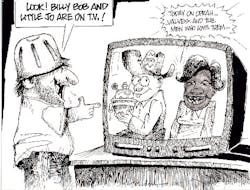STAN: The September puzzler asked why the plant instrument engineer tells you that the control schemes and instruments successfully used at other locations will not work in his plant. Since we ruled out dropping a control valve on his head, we are left with an answer from Henree Pernash Locknester PhD, DD, MS, GED, a certifiable automation engineer.
Henree: The answer all depends on where the new plant is located. If it is in Southern Texas, you need to take the plants instrument engineer and maintenance supervisor out for some steaks and Lone Star beer. If the plant is located in the St. Louis area, take them out for some steaks and Budweiser beer. If the plant is located in New England, take them out for some steaks and well, you get the idea.
Greg: Now for something completely different. We are lucky enough to have the transcript of the guest appearance of a process control engineer from Texas on a prominent day time talk show. Needless to say the audience went wild with applause at the long-awaited chance to find out more about what is under the covers in this mystifying profession.Teksun: Ahm uh big fayun and haly preciate being on TayVay. Did yew know thet thuh pipelines are bigger in Teksus, which makes thuh valves bigger, which makes thuh stick-slip bigger, which makes thuh limit cycle bigger and control more difakult?
Host: Tell us about your sensitive side.
Teksun: Ah am fixin tuh git fine valves for my rilly important loops and use model-predictive control tuh do uh rilly good job of simultanusly throttling Big Hoss and Little Jo tuh cover uh rilly big flow range without split range.
Host: How does this make you feel?
Teksun: It jes make me feyul az fine az frogs hair.
Host: How do you get in touch with yourself?
Teksun: Ah levus thet tuh ma wife.
Host: Control TalkThe Early Years is our book of month. All that talk about model-based control, decoupling, and invcrse response made our readers hot. Is it going to end up in a classroom?
Teksun: Thets uh hoot and uh hollar. Ah kinduh doubt professors will want it for theez 10 raysuns.
Top 10 Reasons Why a Practical Book on Control Wont be a College Text
- Costs less than $50
- None of the authors have PhDs
- Contains Top 10 lists
- Shows flow sensors upstream instead of downstream of the control valve
- Discusses stick-slip and backlash
- Shows unmeasured load upsets as inputs to the process
- Includes field implementation considerations
- Estimates tuning settings to just one decimal place
- Doesnt use tensor analysis for flow loops
- Depicts signal lines in figures as electronic instead of the pneumatic academic standard
Greg: Since the response to our puzzlers has been puzzling, were going to end each column with a trend chart of the month and simply ask, What is wrong? The only clue will be in the grand academic tradition of giving the dynamics of the process and ignoring the effect of the valve, sensor and transmitter. In other words, the process gain, delay (dead time), and lag (time constant) in the heading of the trend chart are exclusive of non-ideal instrumentation and implementation of the loop.
This Month's Puzzler
Waiting for an Invitation?What is a cause of the hesitation and slowness in the approach of the process variable to its new set point in the following trend: Process Gain = 1, Delay = 10 sec, and Lag = 5 sec?Send an e-mail with your answer to The Puzzler, CONTROL questions, or comments to [email protected].| About the Authors |

Leaders relevant to this article:





